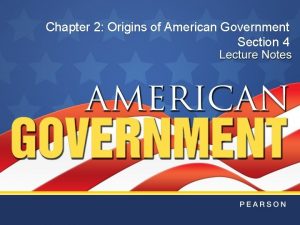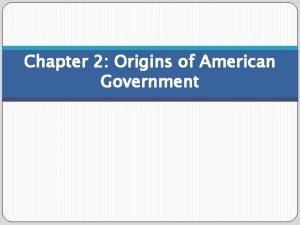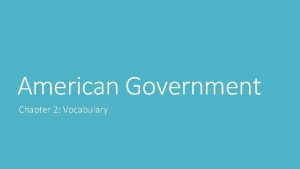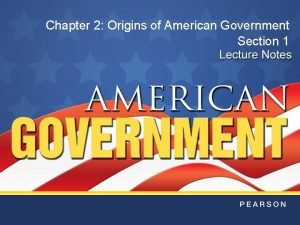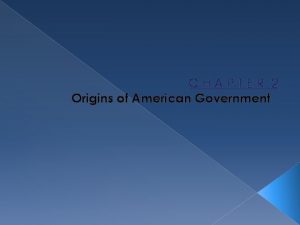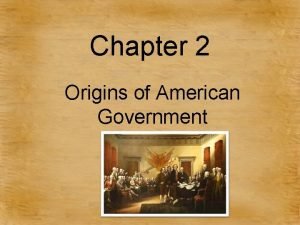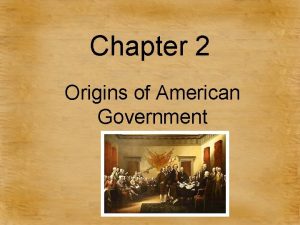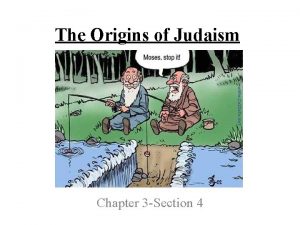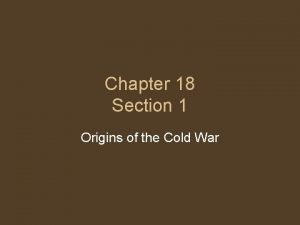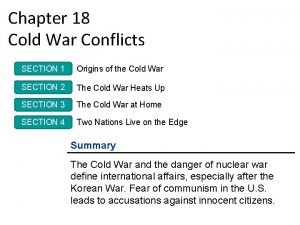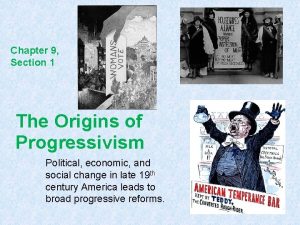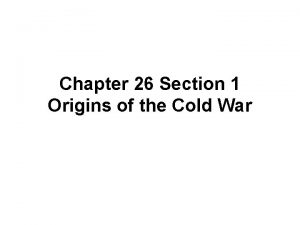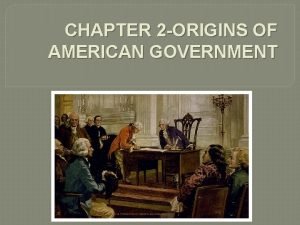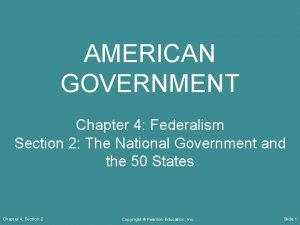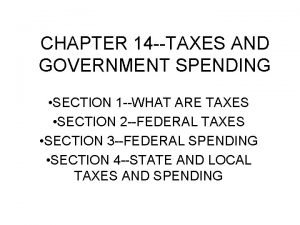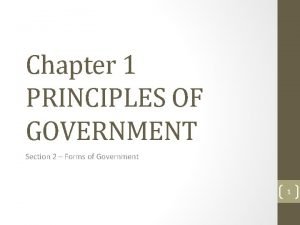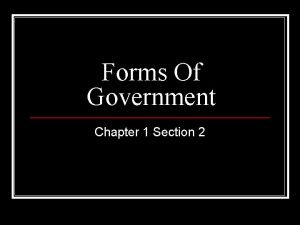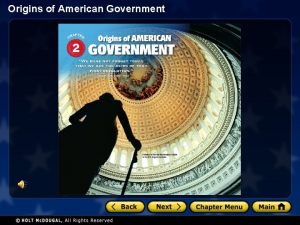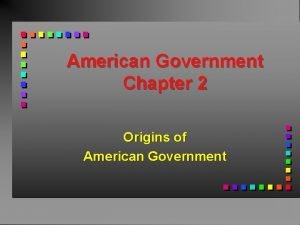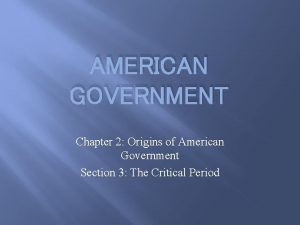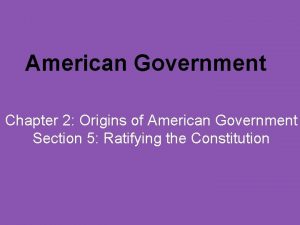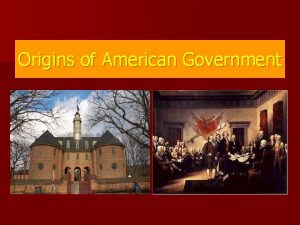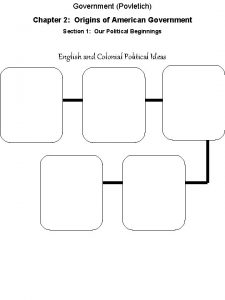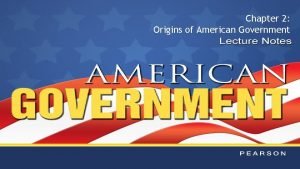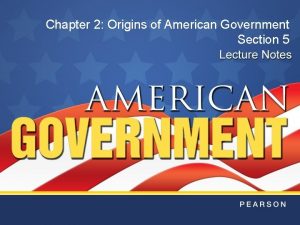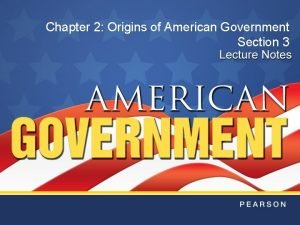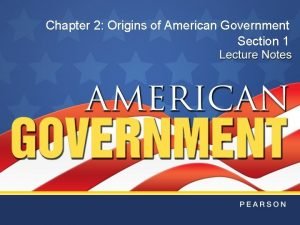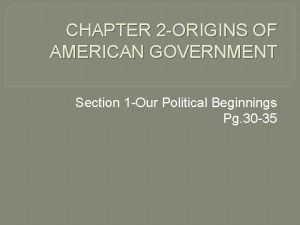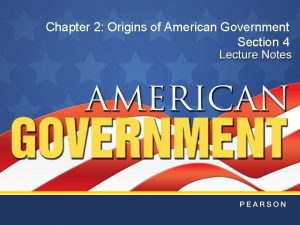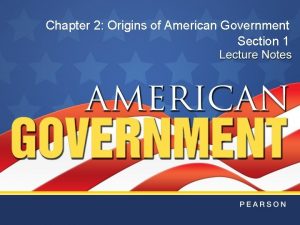Chapter 2 Origins of American Government Section 2



















- Slides: 19

Chapter 2: Origins of American Government Section 2

Objectives 1. Explain how Britain’s colonial policies contributed to the growth of self-government in the colonies. 2. Identify the major steps that led to growing feelings of colonial unity. 3. Compare the First and the Second Continental Congresses. 4. Analyze the ideas in the Declaration of Independence. 5. Summarize the common features of the first State constitutions. Chapter 2, Section 2 Copyright © Pearson Education, Inc. Slide 2

Key Terms • confederation: a joining of several different groups for a common purpose • Albany Plan of Union: Benjamin Franklin’s proposal that the 13 colonies form a congress to raise armed forces, regulate trade, and deal jointly with Native Americans • delegate: a representative • popular sovereignty: the principle that government exists only with the consent of the governed Chapter 2, Section 2 Copyright © Pearson Education, Inc. Slide 3

Introduction • What events and ideas led to American independence? – Unpopular British colonial policies, such as taxation without representation. – Growing political unity among the colonies. – Colonial protests against British policies. – British efforts to punish some colonies for showing independence. – Fighting between colonists and British soldiers. Chapter 2, Section 2 Copyright © Pearson Education, Inc. Slide 4

British Colonial Policies • The colonies became used to a large degree of selfrule for many years. – Distance made it hard for Parliament to manage colonial affairs or enforce trade laws. – Colonial legislatures took on broader powers, withholding pay from governors who disagreed with legislative proposals. – Britain provided colonial defense, managed foreign affairs, and provided a common currency and market. – Taxation was low and interference with colonial affairs was minimal. Chapter 2, Section 2 Copyright © Pearson Education, Inc. Slide 5

British Policies Change • Checkpoint: How did Britain’s dealings with the colonies change? When did they change? – After King George III came to power in 1760, British policies changed. – Parliament expanded and enforced laws to control colonial trade. – Parliament passed new taxes to pay for British troops stationed in North America. • Colonists had no say in these policies and protested “taxation without representation. ” • British leaders ignored these complaints. Chapter 2, Section 2 Copyright © Pearson Education, Inc. Slide 6

Early Efforts at Unity • Early efforts to unite the colonies failed. – Benjamin Franklin’s proposed Albany Plan of Union in 1754 would have created a colonial congress, but was rejected by the colonies. • In 1765, Britain passed the Stamp Act. – This law required a stamp to be bought for all legal documents and newspapers. Chapter 2, Section 2 Copyright © Pearson Education, Inc. Slide 7

The Stamp Act Congress • Nine colonies responded by forming the Stamp Act Congress in New York. – They sent a Declaration of Rights and Grievances to the king. This was the first unified colonial protest. – Parliament repealed the Stamp Act. Chapter 2, Section 2 Copyright © Pearson Education, Inc. Slide 8

Tensions Grow • New laws continued to anger colonists. – They responded with boycotts and violence • Colonists created Committees of Correspondence to organize resistance. • Events like the Boston Massacre and Boston Tea Party raised tensions. Chapter 2, Section 2 Copyright © Pearson Education, Inc. Slide 9

First Continental Congress • Met in Philadelphia in 1774 in response to the Intolerable Acts • Included delegates from every colony but Georgia. Among them were John Adams, George Washington, and John Jay. – Sent a Declaration of Rights to King George that protested Britain’s colonial policies. – Urged colonists to boycott trade with England until hated laws were repealed. – Gained the support of all 13 colonial legislatures and called for a second Congress to meet the following May. Chapter 2, Section 2 Copyright © Pearson Education, Inc. Slide 10

Second Continental Congress • Met in Philadelphia in 1775 • Every colony sent delegates. John Hancock was chosen president of the Congress. • The Battles of Lexington and Concord had already been fought and the Revolutionary War begun. • A continental army was created and George Washington was made commander-in-chief. Chapter 2, Section 2 Copyright © Pearson Education, Inc. Slide 11

Second Continental Congress, cont. • This Congress became America’s first national government, from 17761781. – It had legislative and executive powers. – During the war, it raised a military, printed and borrowed money, and made foreign treaties. – Benjamin Franklin (right) was a leading member. Chapter 2, Section 2 Copyright © Pearson Education, Inc. Slide 12

Breaking from Britain • Congress resolved to break away from Britain in 1776. – Benjamin Franklin, John Adams, Roger Sherman, Robert Livingston, and Thomas Jefferson were named to write a proclamation of independence. – The delegates declared independence on July 2, 1776 and adopted the Declaration on July 4. Chapter 2, Section 2 Copyright © Pearson Education, Inc. Slide 13

Declaration of Independence • Checkpoint: What was the purpose of the Declaration of Independence? – The Declaration severed ties with Great Britain and created a unique nation • No political system had ever been formed on the principles of equality, human rights, and representative government that derived its authority from the will of the people. Chapter 2, Section 2 Copyright © Pearson Education, Inc. Slide 14

The Road to Independence • English colonists brought with them the ideas of the Enlightenment and limited government. – How did early events contribute to the signing of the Declaration of Independence? Chapter 2, Section 2 Copyright © Pearson Education, Inc. Slide 15

The Road to Independence, cont. • In time, these ideas began to shape the ideal of American government and the actions of the colonists. – How did early events contribute to the signing of the Declaration of Independence? Chapter 2, Section 2 Copyright © Pearson Education, Inc. Slide 16

State Constitutions • The Congress urged colonies to write their own constitutions. – A constitution sets out the principles, structures, and processes of government. – Most states adopted constitutions in 1776 and 1777. • The Massachusetts constitution of 1780 is the oldest of the current state constitutions. Chapter 2, Section 2 Copyright © Pearson Education, Inc. Slide 17

State Constitutions, cont. • Popular sovereignty - government must have the consent of the governed • Limited government - government has only the powers granted by the people in the constitution • Civil rights and liberties - seven state constitutions included a bill of rights defining basic freedoms • Separation of powers - power divided among legislative, executive, and judicial branches • Checks and balances - each branch could limit the power of the other branches • State constitutions gave most of the power to the legislature, set short terms of office, and limited the right to vote. Chapter 2, Section 2 Copyright © Pearson Education, Inc. Slide 18

Review • Now that you have learned what events and ideas led to American independence, go back and answer the Chapter Essential Question. – How does the Constitution reflect the times in which it was written? Chapter 2, Section 2 Copyright © Pearson Education, Inc. Slide 19
 Origins of american government section 4
Origins of american government section 4 Origins of american government section 1
Origins of american government section 1 Origins of american government section 1
Origins of american government section 1 Origins of american government vocabulary
Origins of american government vocabulary Chapter 2 origins of american government answer key
Chapter 2 origins of american government answer key Chapter 2: origins of american government worksheet answers
Chapter 2: origins of american government worksheet answers Chapter 2 lesson 1 origins of american government
Chapter 2 lesson 1 origins of american government Chapter 2 origins of american government
Chapter 2 origins of american government Chapter 3 section 4 the origins of judaism
Chapter 3 section 4 the origins of judaism Origins of the cold war chapter 18 section 1
Origins of the cold war chapter 18 section 1 Origins of the cold war chapter 18 section 1
Origins of the cold war chapter 18 section 1 The origins of progressivism chapter 9 section 1
The origins of progressivism chapter 9 section 1 Chapter 26 section 1 origins of the cold war
Chapter 26 section 1 origins of the cold war Foundations of government guided reading activity section 1
Foundations of government guided reading activity section 1 Chapter 2 american government
Chapter 2 american government Chapter 4 federalism answer key
Chapter 4 federalism answer key Chapter 14: taxes and government spending section 1
Chapter 14: taxes and government spending section 1 Forms of government chapter 1 section 2
Forms of government chapter 1 section 2 Chapter 1 principles of government
Chapter 1 principles of government Chapter 1 section 2 forms of government
Chapter 1 section 2 forms of government
